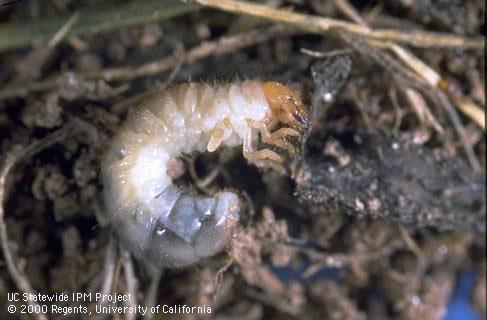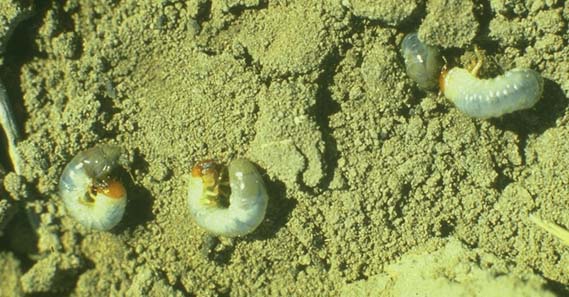


Description and Damage: White grubs are the lar-val stages of several species of May or June beetles. Larvae are “C-”shaped with white bodies, tan or brown heads, and three pairs of small legs. Larvae vary in size according to age and species. Fully grown larvae are 1 to 1 1 /2 inches long. The last abdominal segment is transparent, with dark digested material visible inside. Larvae damage sorghum by feeding on the roots. Small seedlings may be killed, resulting in stand loss. Severely pruned roots of larger plants cause stunted plants, plant lodging and increased susceptibility to drought and stalk rot organisms. Plant stand losses often appear in irregular (clumped) patterns in a field.
Biology: Adults, commonly called May beetles or June beetles, are brownish black and 1 /2 to 3 /4 inch long. Female beetles lay eggs in cells in the soil near plant roots. Depending on the species, the life cycle may require a year or more to complete. In Texas, larvae overwinter in cells in the soil.
May Beetles (white grubs), Phyllophaga spp.
Plants attacked: Grasses and grain crops, beans and many other cultivated crops.
Description: Adult. The May beetles vary in color and size according to the species but the most common are brown or brownish-black and are 1/2 to 3/4 inches long.
Larva. This stage of the May beetle is commonly called the white grub and has a U-shaped body, brown head and three pairs of legs. Its body is white, and the digested food can be seen through the shiny and transparent tip of the abdomen.
Life History: The winter is passed in the soil in both the adult and larval stages. The length of the life cycle varies according to the species. A common species has a 2-year life cycle, and another develops in 1 year. The female usually deposits eggs during early summer in grass sod. The tiny grubs that hatch from the eggs feed on the plant roots until cold weather when they tunnel downward several inches in the soil where they overwinter. The following spring they move back to the vicinity of the solid surface, feed for 3 or 4 weeks on roots of plants and pupate. The pupa changes to an adult in about 4 weeks but remain inside an earthen cell, prepared by the larva prior to pupation, and emerges in May or June.
Damage: The grub feeds on the roots of many plants. It often kills patches of grass sod and frequently attacks roots of corn and soybean plants. Lodging of plants may be the result of damage by white grubs.